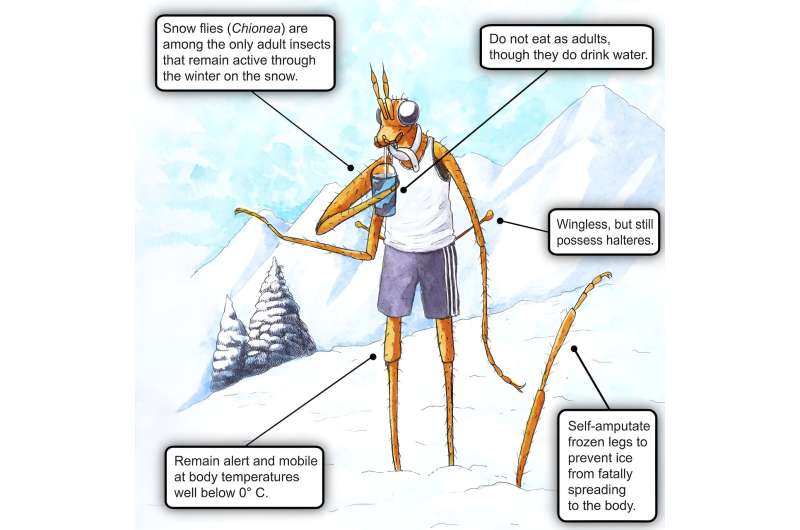September 28, 2023 report
This article has been reviewed according to Science X's editorial process and policies. Editors have highlighted the following attributes while ensuring the content's credibility:
fact-checked
peer-reviewed publication
trusted source
proofread
The chilling tale of snow flies, self-amputation, survival and certain death

Researchers at the Department of Physiology and Biophysics, University of Washington, Seattle, have discovered something peculiar in the survival strategy of the snow fly (Chionea spp.), a flightless crane fly that lives in boreal and alpine environments of the northern hemisphere.
In a paper titled, "Snow flies self-amputate freezing limbs to sustain behavior at sub-zero temperatures," published in Current Biology, the researchers detail, as the title implies, the extreme act of self-amputation of frozen limbs by the snow flies to survive in sub-zero temperatures.
Snow flies can remain active in frigid environments and have been observed running on snow at ambient temperatures as low as –10°C. This is in contrast to most insects, which become physiologically incapacitated at temperatures below the freezing point of water.
Citizen scientists in the form of skiers and mountaineers were recruited to collect snow flies from remote alpine regions of the Pacific Northwest, where the insects can be seen scampering across freshly fallen snow near the tree line. They collected 256 adult snow flies, 20% of which were already missing one or more legs when collected.
Using thermal imaging, the researchers observed the snow flies maintain the ability to walk even with an average body temperature of −7°C. At this temperature, ice crystallization begins to form within the snow fly's bodily fluids, spreading rapidly from the extremities.
Snow flies frequently survive this crystallization by quickly amputating their legs before ice crystallization can spread to their organs. The reaction must be fast, as crystallization that begins in the leg can reach vital organs in just a half second.
The self-amputation of legs consistently occurs at the joint between the femur and the trochanter. Limb self-amputation is common in crane flies as a means of escape, though this usually involves a predator and is typically triggered by mechanical stimuli.
In contrast, snow flies do not respond to pulling or mechanical prodding of their legs. Instead, researchers suspect leg amputation in snow flies may be triggered by thermosensory neurons that detect temperature change during ice crystallization.
While the snow flies habitat is extreme and can result in the occasional self-amputation, living in such an environment has some distinct advantages. Their habitat mostly lacks other animals, including potential snow fly predators. Eggs laid beneath the snow are rarely disturbed, and snow flies have been observed audaciously mating in full view on the surface of the snow for 30 min or more.
As safe and secluded as the snow fly habitat is today, our time to study them may be limited. Human-caused climate change is transforming high-elevation ecosystems, with Washington on track to lose 46% of its end-of-winter snowpack by the 2040s and 70% by the 2080s.
Loss of snowpack is predicted to increase thermal variability and decrease temperatures under the snow where snow flies lay their eggs. Lower temperatures and increased freeze-thaw cycles can also harm plant life that snow fly larvae consume during spring and summer. The radical biome transformation will likely result in the species disappearing altogether.
More information: Dominic Golding et al, Snow flies self-amputate freezing limbs to sustain behavior at sub-zero temperatures, Current Biology (2023). DOI: 10.1016/j.cub.2023.09.002
Journal information: Current Biology
© 2023 Science X Network




















